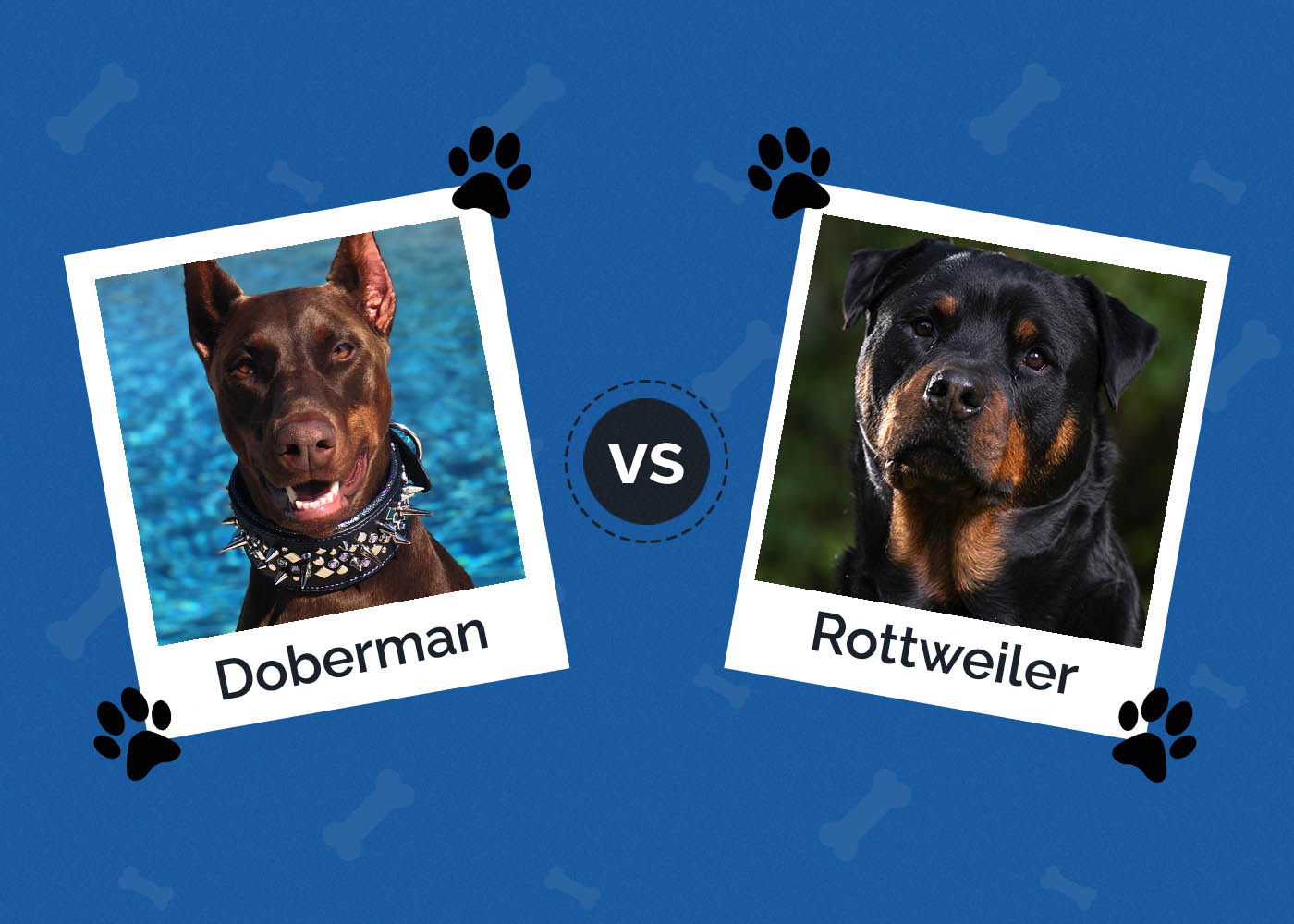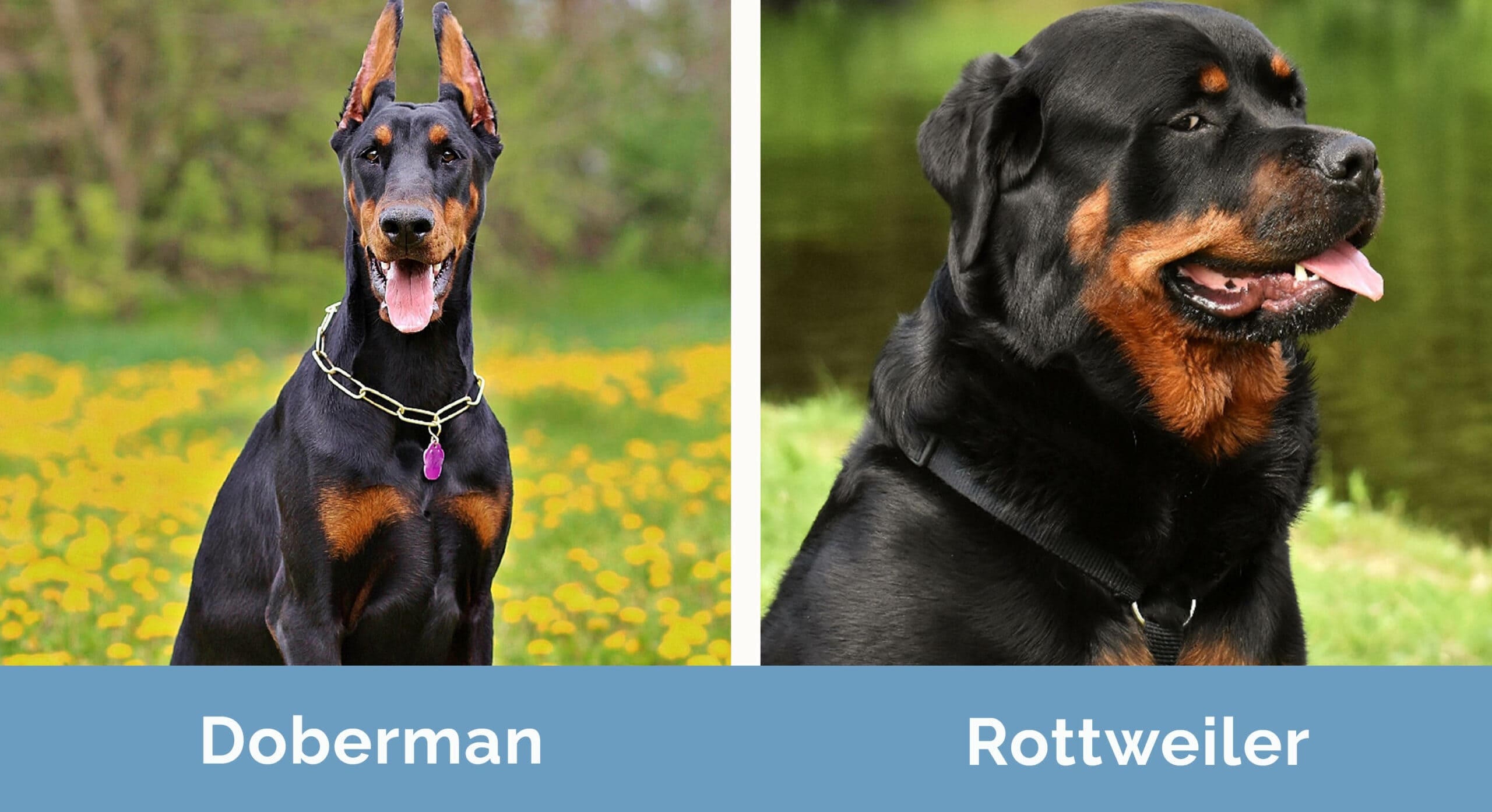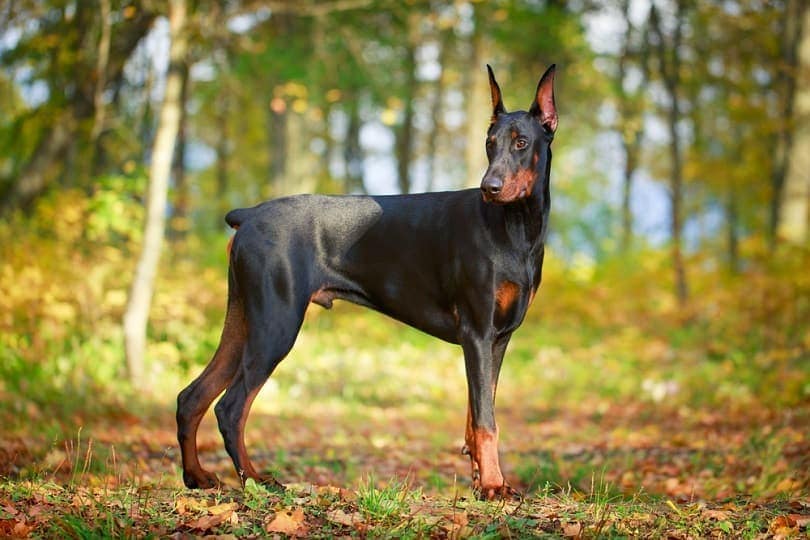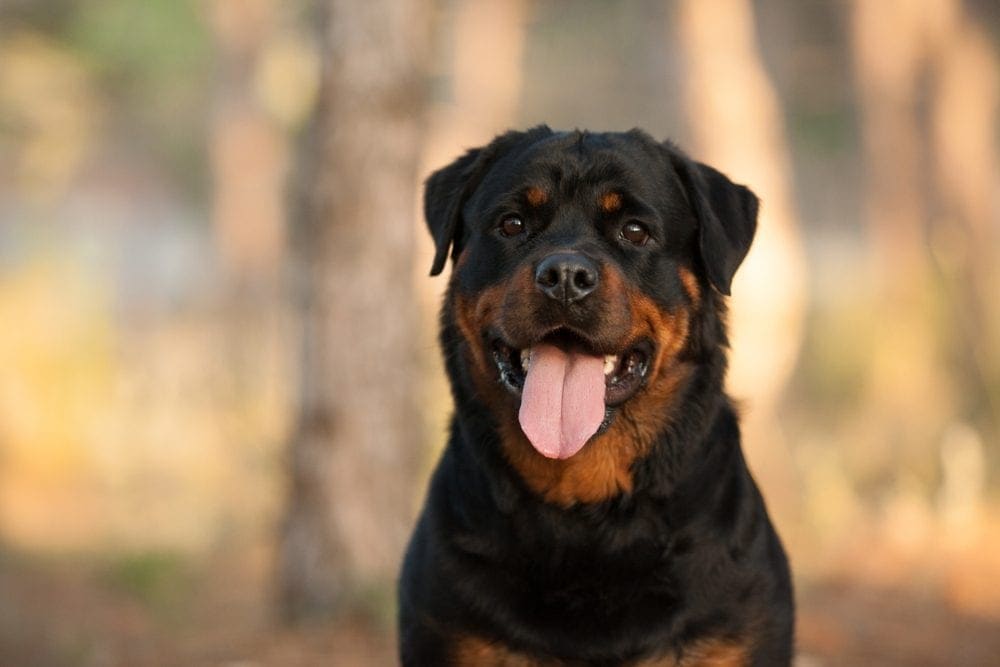Doberman vs Rottweiler: What’s the Difference? (With Pictures)

Updated on

Rottweilers and Doberman Pinschers are both large, noble creatures that were bred to be hard-working animals. Today, both breeds have found success working with militaries and police around the world. They also make incredible companions, family pets, and guard dogs. Interestingly, it’s believed that the Rottweiler is one of the breeds mixed to create the Doberman Pinscher breed.
Since both dogs are known for their intelligence, loyalty, and courage, it could be hard to pick between them if you’re looking to add one of these great animals to your family. Aside from their appearances, what differences are there between these two similar breeds? Let’s take a closer look at the Doberman and Rottweiler to find out.
Doberman vs Rottweiler: Visual Differences

A Quick Overview
- Average Height (adult): 26 inches
- Average Weight (adult): 70 pounds
- Lifespan: 10-13 years
- Exercise: 60 minutes
- Grooming Needs: Minimal
- Family-friendly: Absolutely
- Dog-friendly: Usually
- Trainability: High
- Average Height (adult): 25 inches
- Average Weight (adult): 110 pounds
- Lifespan: 8-11 years
- Exercise: 20-60 minutes
- Grooming Needs: Minimal
- Family-friendly: Absolutely
- Dog-friendly: With socialization
- Trainability: High
Doberman Overview

One of the top 20 popular breeds according to the AKC, Doberman Pinschers were originally bred in Germany in the late 1800s. The breed was created by a single man, Louis Dobermann, a tax collector who needed protection from local bandits. He crossed several different breeds together to create the Doberman, though there are no records to show what breeds he used. It is believed, however, that the Rottweiler is one of those breeds.
Once Louis died, other German breeders continued his work, developing the Doberman into a supremely capable canine. They worked to make them as smart, strong, brave, and tough as possible, giving them a reputation as aggressive and headstrong.
Through continued breeding, these negative traits were later removed from the breed, giving us the loving, loyal, yet still courageous Dobermans we know today and dropping the “Pinscher” from their name along the way.
Personality
Today, Dobermans are known for their incredible intelligence and high levels of energy. They’re extremely active and energetic, playful and fun to be with. They’re also some of the most loyal creatures in the canine kingdom, which is part of why they make such excellent guard dogs. If their family is under threat, expect a vicious and terrifying animal. But under normal circumstances, they’re not known to be aggressive. In fact, they’re actually quite gentle, loving animals.
Because they’re such sweet dogs, Dobermans often do very well with children, making them excellent family pets. They even do well with other pets, though you’ll want to socialize them properly.

Training
There’s good reason why Dobermans have been employed by militaries and police forces all across the world. These dogs are exceptionally smart, and they learn very quickly. They can understand complex concepts that are far beyond the capabilities of other breeds.
That said, these are also physically strong dogs with equally strong wills. You’ll need a firm hand to train one properly. They won’t respond to a leader they don’t respect. As such, it’s often best to only attempt training a Doberman if you have previous dog-training experience.
Health and Care
Overall, Dobermans are known for being hardy, robust canines. Even still, there are quite a few diseases that are known to occasionally present themselves in the breed, including:
- Von Willebrand’s Disease
- Hip Dysplasia
- Wobbler’s Syndrome
- Narcolepsy
- Bloat
- Cardiomyopathy
- Hypothyroidism
- Progressive Retinal Atrophy
Caring for a Doberman isn’t too demanding, aside from their great exercise needs. Because this breed is so highly energetic, you’ll need to ensure that you’re providing plenty of physical activity. Likewise, their high levels of intelligence mean that they need mental stimulation. Otherwise, you run the risk of having a bored stud of a canine athlete turning to destructive behaviors. Not a great combination.
Dobermans also don’t like to be left alone. These are not outside dogs that you can just keep in the backyard. However, due to their size and active nature, they are best suited for homes with large yards where they can romp, play, and release their excess energy. Just make sure to provide plenty of personal attention as well.
When it comes to grooming, Dobermans need the minimum. A light brushing is all their coat needs. Make sure to keep an eye on their nails, teeth, and ears as well. Bathing should only be done as necessary.
Rottweiler Overview

Originally, Rottweilers were bred for driving cattle. Once the railroad replaced cattle drives as the main way to transport cattle, this noble breed nearly went extinct. However, they survived, going on to become one of the first breeds of canine used in military and police work.
After WWII, Rottweilers started growing in popularity. Today, they’re still one of the most popular breeds in America. A lot of this is due to their excellent status as hard workers, loyal guardians, and lovable family pets.
These dogs are very large, weighing as much as 130 pounds. They’ve got large heads, thick, muscled bodies, and a very regal look that makes them seem quite valiant, which they are.
Personality
Once you understand the Rottweiler’s personality, you’ll know why they’re so popular. This breed is known for its calm demeanor. Despite this, they’re very courageous and self-confident. They’re patient animals, never shy, but showing a definite aloofness around strangers and newcomers.
Rottweilers are incredibly intelligent, which is part of why they’ve been so successful working with police and militaries. They’re also extremely loyal, making them excellent guard dogs and family pets. Likewise, their gentleness makes them perfect for families, even if their large stature can be an accidental danger to small children.
Rottweilers aren’t as energetic as Dobermans. They require far less exercise. They’re also not very excitable dogs, generally remaining calm and non-aggressive unless they feel their family is in danger.
Training
Rottweilers have incredible work ethic. That’s part of why they make such great working dogs. After all, the breed was created for working. They’re also highly intelligent, and the combination makes them great at learning new commands, tasks, and jobs.

That doesn’t mean that it’s going to be easy to train your Rottweiler though. Just by virtue of their size and strength, they can be difficult to handle. If you want to train a Rottie, you’ll have to establish leadership early and firmly, without being harsh or aggressive. Rottweilers won’t respect a leader who isn’t assertive.
Once you earn your Rottweiler’s respect, you’ll be able to train them somewhat easily, though they can sometimes be stubborn.
Health and Care
Similar to Dobermans, Rottweilers are generally regarded as healthy, hardy dogs. That doesn’t mean they’re not susceptible to disease and illness, however. If you’re going to keep a Rottie, you’ll want to look out for health concerns such as:
- Hip Dysplasia
- Bloat
- Hypothyroidism
- Allergies
- Osteosarcoma
- Aortic Stenosis/Sub-aortic Stenosis
- Elbow Dysplasia
Rottweilers are pretty easy to care for. They aren’t the most energetic breed, so you won’t need to spend as much time exercising them. However, they’ll still need lots of mental stimulation to prevent boredom and destructive behaviors from surfacing.
When it comes to grooming, Rottweilers need just the minimum. Some light brushing and an occasional bath will keep a Rottie in prime condition. Just make sure to keep up on their nails, ears, and teeth as well.
Doberman Rottweiler: Which Breed Is the Best Fit for You?
If you can only have one dog and you’re trying to decide between a Doberman and a Rottweiler, you’ve got a hard decision in front of you. These dogs are both incredible family pets, undyingly loyal, great guard dogs, loving, and highly intelligent. Both can be trained pretty easily if you know what you’re doing. So, which one is a better fit for you?
Dobermans need a lot more physical activity. If you don’t have an hour each day at the minimum to devote to exercising your dog, then you’d be better off with a Rottweiler since they don’t need nearly as much exercise.
If you don’t have a big yard, then again, a Rottweiler is a better choice. Dobermans need a lot more space to work out their excess energy.
On the other hand, if you’re an athletic person who spends a lot of time hiking, running, or doing other activities that you want a dog to accompany you on, then you’d be better off with a Doberman. They’ll be thrilled to spend so much time doing physical activities together. But that might be too much for a Rottweiler.
If you’re looking for a loyal family pet, working dog, or guard dog, you really can’t go wrong with either breed.
Featured Image Credit: (L) Jen B, Unsplash | (R) Rogue Productions LLC, Shutterstock













